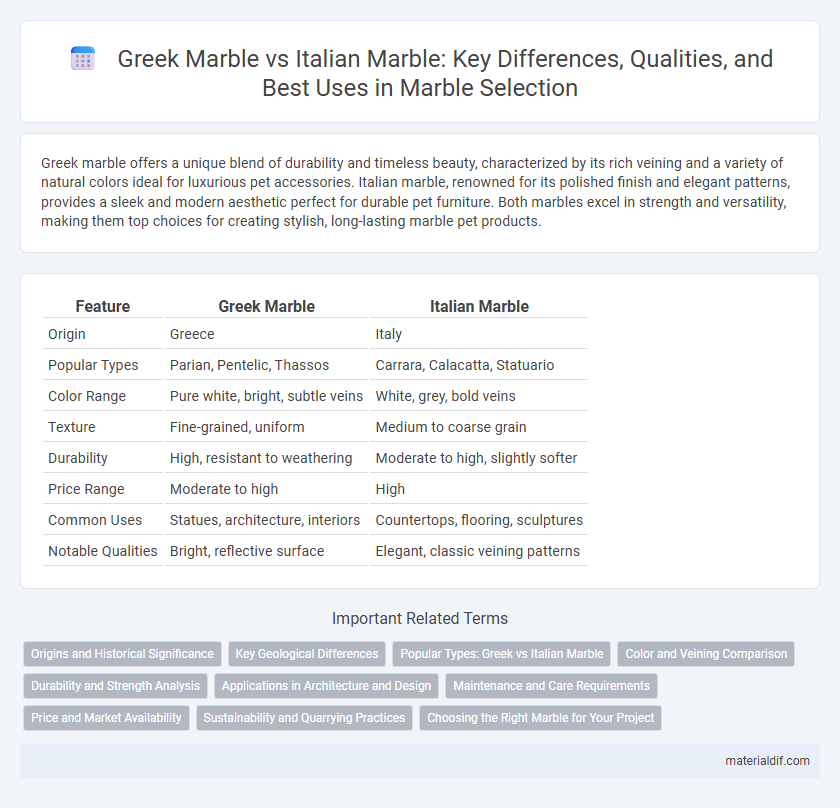Greek marble offers a unique blend of durability and timeless beauty, characterized by its rich veining and a variety of natural colors ideal for luxurious pet accessories. Italian marble, renowned for its polished finish and elegant patterns, provides a sleek and modern aesthetic perfect for durable pet furniture. Both marbles excel in strength and versatility, making them top choices for creating stylish, long-lasting marble pet products.
Table of Comparison
| Feature | Greek Marble | Italian Marble |
|---|---|---|
| Origin | Greece | Italy |
| Popular Types | Parian, Pentelic, Thassos | Carrara, Calacatta, Statuario |
| Color Range | Pure white, bright, subtle veins | White, grey, bold veins |
| Texture | Fine-grained, uniform | Medium to coarse grain |
| Durability | High, resistant to weathering | Moderate to high, slightly softer |
| Price Range | Moderate to high | High |
| Common Uses | Statues, architecture, interiors | Countertops, flooring, sculptures |
| Notable Qualities | Bright, reflective surface | Elegant, classic veining patterns |
Origins and Historical Significance
Greek marble, notably from quarries like Pentelic and Thassos, is renowned for its pure white and fine-grained texture, historically used in iconic ancient structures such as the Parthenon. Italian marble, particularly Carrara marble from Tuscany, boasts a rich heritage dating back to Roman times, celebrated for its high quality and widespread use in Renaissance sculptures by masters like Michelangelo. The distinct origins of Greek and Italian marble highlight their significant cultural and artistic contributions to classical and Renaissance architecture.
Key Geological Differences
Greek marble is predominantly composed of pure calcite with a fine-grained texture, originating from ancient metamorphic formations in regions like Penteli and Paros, known for their high density and low porosity. Italian marble, especially Carrara marble, features a mix of calcite and dolomite, formed through complex geological processes involving regional metamorphism in the Apuan Alps, resulting in varied grain sizes and veining patterns. These geological distinctions influence their durability, translucency, and suitability for different architectural and sculptural applications.
Popular Types: Greek vs Italian Marble
Greek marble, renowned for its pure white varieties like Pentelic and Thassos, offers pristine aesthetics favored in classical sculpture and luxury interiors. Italian marble, exemplified by Carrara and Calacatta, is celebrated for its elegant veining and versatility in modern architecture and design. Both types dominate global markets due to their unique textures, durability, and historical significance in art and construction.
Color and Veining Comparison
Greek marble features predominantly pure white tones with subtle gray and blue veins, offering a sleek and elegant appearance favored in classical sculptures and modern architecture. Italian marble, especially varieties like Carrara and Calacatta, showcases a broader color spectrum ranging from bright whites to creamy hues, often highlighted by dramatic and bold veining patterns in gray or gold. The contrast between Greek marble's delicate veining and Italian marble's pronounced, artistic streaks defines their unique aesthetic appeal in luxury interior design and architectural applications.
Durability and Strength Analysis
Greek marble, particularly from regions like Penteli and Thassos, is renowned for its exceptional density and resistance to weathering, making it highly durable for both indoor and outdoor applications. Italian marble, especially Carrara and Calacatta varieties, offers remarkable strength combined with a finer grain structure, providing enhanced load-bearing capacity and polished finish longevity. Both marbles excel in durability, but Greek marble tends to have superior hardness, while Italian marble is prized for its balance of strength and aesthetic refinement.
Applications in Architecture and Design
Greek marble, known for its pure white quality and fine grain, is extensively used in classical sculpture, luxury flooring, and intricate wall cladding, offering timeless elegance in architectural designs. Italian marble, particularly Carrara and Calacatta varieties, is prized for its distinctive veining and durability, making it ideal for contemporary countertops, bathroom vanities, and statement staircases. Both types enhance aesthetic appeal and structural integrity, with Greek marble favored in restoration projects and Italian marble dominating modern luxury interiors.
Maintenance and Care Requirements
Greek marble typically requires less maintenance due to its higher density and lower porosity, making it more resistant to stains and scratches compared to Italian marble. Italian marble, known for its luxurious appearance and softer texture, demands more frequent sealing and careful cleaning to prevent etching and discoloration. Regular use of pH-neutral cleaners and prompt attention to spills are essential to preserve the longevity and aesthetic of both types.
Price and Market Availability
Greek marble generally offers a more competitive price point compared to Italian marble, making it a popular choice in cost-sensitive projects. Italian marble, renowned for its premium quality and unique patterns, commands higher prices and is often preferred for luxury applications. Market availability favors Greek marble due to larger quarry outputs and more diverse product ranges, while Italian marble remains limited but highly sought after.
Sustainability and Quarrying Practices
Greek marble is renowned for its sustainable quarrying practices, emphasizing environmental preservation through controlled extraction and land restoration. Italian marble quarries implement advanced technologies to minimize waste and reduce carbon emissions, supporting sustainable production cycles. Both Greek and Italian marble industries prioritize eco-friendly methods, but Greek marble often highlights rigorous government regulations ensuring biodiversity protection during quarry operations.
Choosing the Right Marble for Your Project
Greek marble is renowned for its pure white quality and fine grain, making it ideal for sculptures and elegant interiors, while Italian marble, such as Carrara and Calacatta, is prized for its unique veining and luxurious appeal in flooring and countertops. Selecting the right marble depends on factors like durability, color consistency, and the intended aesthetic impact, with Greek marble often chosen for minimalist designs and Italian marble favored for dramatic, statement pieces. Understanding these distinctions helps architects and designers match marble types to project requirements, ensuring both beauty and functionality.
Greek marble vs Italian marble Infographic

 materialdif.com
materialdif.com